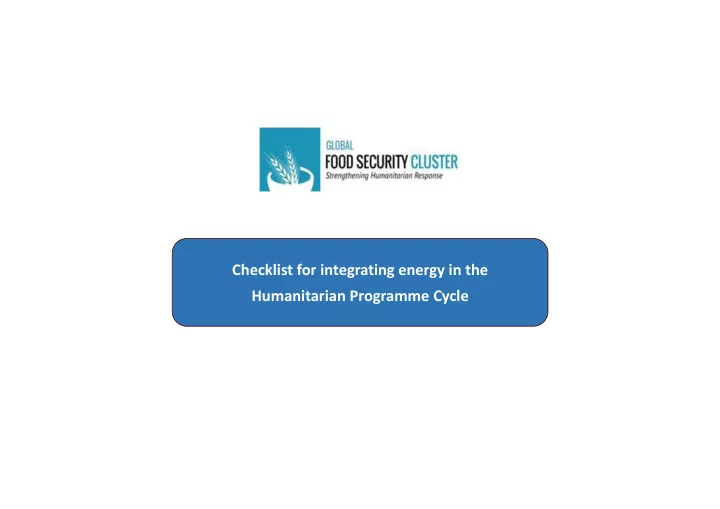

Checklist for integrating energy in the Humanitarian Programme Cycle
Key steps for integrating energy in HPC elements 1. Emergency response preparedness 2. Needs assessment 3. Strategic response planning 4. Response implementation 5. Resource mobilization 6. M&E 7. Inter-cluster coordination
Preparedness Key minimum steps Responsibility Further resources WFP Handbook on SAFE 1. Inclusion of fuel needs and energy sources as Cluster Coordinator and (http:// documents.wfp.org/stellent/groups/public/ a priority in humanitarian contingency planning partners documents/newsroom/wfp252989.pdf ) documents/guidelines, humanitarian Global Strategy for Safe Access to Fuel and Energy policy/strategy, emergency food security (SAFE): A UNHCR Strategy 2014-2018 (http://www.unhcr.org/530f11ee6.html) assessments Cluster Coordinator, WFP Handbook on SAFE 2. Collection and analysis of primary and (http://documents.wfp.org/stellent/groups/public/d Information Management secondary data at the cluster level for the ocuments/newsroom/wfp252989.pdf) Officer and/or Reporting establishment of a baseline for fuel needs and Officer and partners uses, fuel supply, cooking technologies and cooking practices. WFP Handbook on SAFE 3. Training on Safe Access to Fuel and Energy Cluster Coordinator and (http://documents.wfp.org/stellent/groups/public/d (SAFE) to ensure a minimum level of skills partners ocuments/newsroom/wfp252989.pdf) available within the Cluster to carry out key fuel- FAO SAFE Guidance Note (http://www.fao.org/fileadmin/user_upload/emerge related activities. ncies/docs/Guidance%20Note%20Safe.pdf)
Needs assessment Key minimum steps Responsibility Further resources 1. Engage with agencies/focal points from WFP Handbook on SAFE Cluster Coordinator, (http://documents.wfp.org/stellent/groups/public relevant sectors, e.g. environment and natural assessment experts and/or /documents/newsroom/wfp252989.pdf) resources in the design of fuel needs and fuel IMO and partners supply assessments, collection and analysis of data. IASC Gender Handbook (section on Gender and 2. Common cluster understanding/contextual Cluster Coordinator and NFIs) analysis of fuel use, cooking practices and the partners (http://www.humanitarianinfo.org/iasc/documen associated socio-cultural context, taking into ts/subsidi/tf_gender/IASC%20Gender%20Handbo ok%20(Feb%202007).pdf) account the different needs/vulnerabilities of men, women, boys and girls; and with a protection lens. 3. Key findings around fuel needs and fuel Cluster Coordinator and supply are fed into the response framework and partners strategic planning.
Strategic response planning Key minimum steps Responsibility Further resources 1. Engage with relevant specialized WFP Handbook on SAFE Cluster coordinator and (http://documents.wfp.org/stellent/groups/public agencies/focal points in country to provide partners /documents/newsroom/wfp252989.pdf) inputs to Strategic Planning (Strategic Response FAO SAFE Guidance Note Plan, Crisis Response Plan) so that its objective, (http://www.fao.org/fileadmin/user_upload/eme narrative, activities and indicators appropriately rgencies/docs/Guidance%20Note%20Safe.pdf) reflect the concrete challenges associated with the collection, supply and/or use of fuel. Global Strategy for Safe Access to Fuel and Energy 2. Finalization of joint/inter-agency SAFE Cluster coordinator and (SAFE): A UNHCR Strategy 2014-2018 strategy either through the cluster or through an partners (http://www.unhcr.org/530f11ee6.html) inter-cluster thematic working group. 3. Resources needed to integrate fuel and Cluster coordinator and energy issues during a response are routinely partners incorporated into project plans and proposals when relevant
Response implementation Key minimum steps Responsibility Further resources 1. Common vulnerability criteria for selection of Cluster Coordinator WFP Handbook on SAFE (http://documents.wfp.org/stellent/groups/public beneficiaries (assessment findings). Criteria and and partners /documents/newsroom/wfp252989.pdf) beneficiary selection processes should be public where possible. Criteria as consistent as possible with vulnerability criteria developed by other clusters. WFP Handbook on SAFE 2. Safe distribution and inclusive delivery mechanisms Cluster Coordinator (http://documents.wfp.org/stellent/groups/public of fuels and energy technologies. Modalities that take and partners /documents/newsroom/wfp252989.pdf) into account feedback mechanisms, rights/entitlements of beneficiaries, training of beneficiaries and code of conduct. WFP Handbook on SAFE 3. Develop common messaging protocol and common Cluster Coordinator (http://documents.wfp.org/stellent/groups/public cluster messaging for sharing information with affected and partners /documents/newsroom/wfp252989.pdf) communities & common cluster feedback processes to inform partners’ programmes.
Resource Mobilization Key minimum steps Responsibility Further resources 1. Advocate/highlight to donors the multi-sectoral Cluster Coordinator WFP Handbook on SAFE (http://documents.wfp.org/stellent/groups/public challenges associated with the collection, production, and partners /documents/newsroom/wfp252989.pdf) supply and use of fuel and the need to implement fuel- related activities as a life-saving intervention. Cluster Coordinator 2. Encourage cluster to commit adequate resources for and partners the deployment of staff with the necessary mandate and skills to develop and support the implementation of fuel-related activities 3. Encourage partners to incorporate budgets for SAFE Cluster Coordinator activities. and partners
Monitoring & Evaluation Key minimum steps Responsibility Further resources 1. Ensure that quantitative and qualitative post- Cluster Coordinator WFP Handbook on SAFE (http://documents.wfp.org/stellent/groups/public and partners distribution monitoring tools are developed. /documents/newsroom/wfp252989.pdf) 2. Conduct a qualitative analysis to see how the Cluster Coordinator commitments related to SAFE made by the Cluster (in and partners the SRP) were operationalized by partners and the impact on communities. 3. Ensure the key tools, data, findings, lessons learned Cluster Coordinator and good practices are shared with gFSC for further and partners dissemination and integration within its work. The cluster should be encouraged to support independent evaluations of the effectiveness and impact of fuel interventions, especially concerning the technologies applied.
Inter-Cluster Coordination Key minimum steps Responsibility Further resources Cluster Coordinator IASC Matrix on Agency Roles and Responsibilites 1. Develop/update a matrix of roles and responsibilities for Ensuring a Coordinated, and partners for fuel-related interventions across various response Multi-Sectoral Fuel Strategy in Humanitarian sectors. Settings (http://postconflict.unep.ch/humanitarianaction/ documents/02_02-04_02-03.pdf) 2. Engage with the Shelter-NFI Cluster to coordinate on IASC Guidance on Inter-Cluster Coordination logistical aspects of fuel and FES provision in acute (http://www.earlyrecovery.info/wp- content/uploads/2013/12/Strategic-Review- emergencies. Piero-Calvi.pdf) 3. Collaborate with the Protection Cluster on assessments of protection risks associated with the collection of firewood in areas of wood scarcity and tension with host communities.
Feedback from Global FSC PQWG • Include the need to take stock of past fuel/stove interventions and what has worked and has not worked; • Include the need to engage with research institutions on appropriate technologies and alternative fuels; • Greater emphasis on the need for advocacy; • Need to highlight the linkages between fuel needs and environmental impacts and depletion of forest resources.
Recommend
More recommend